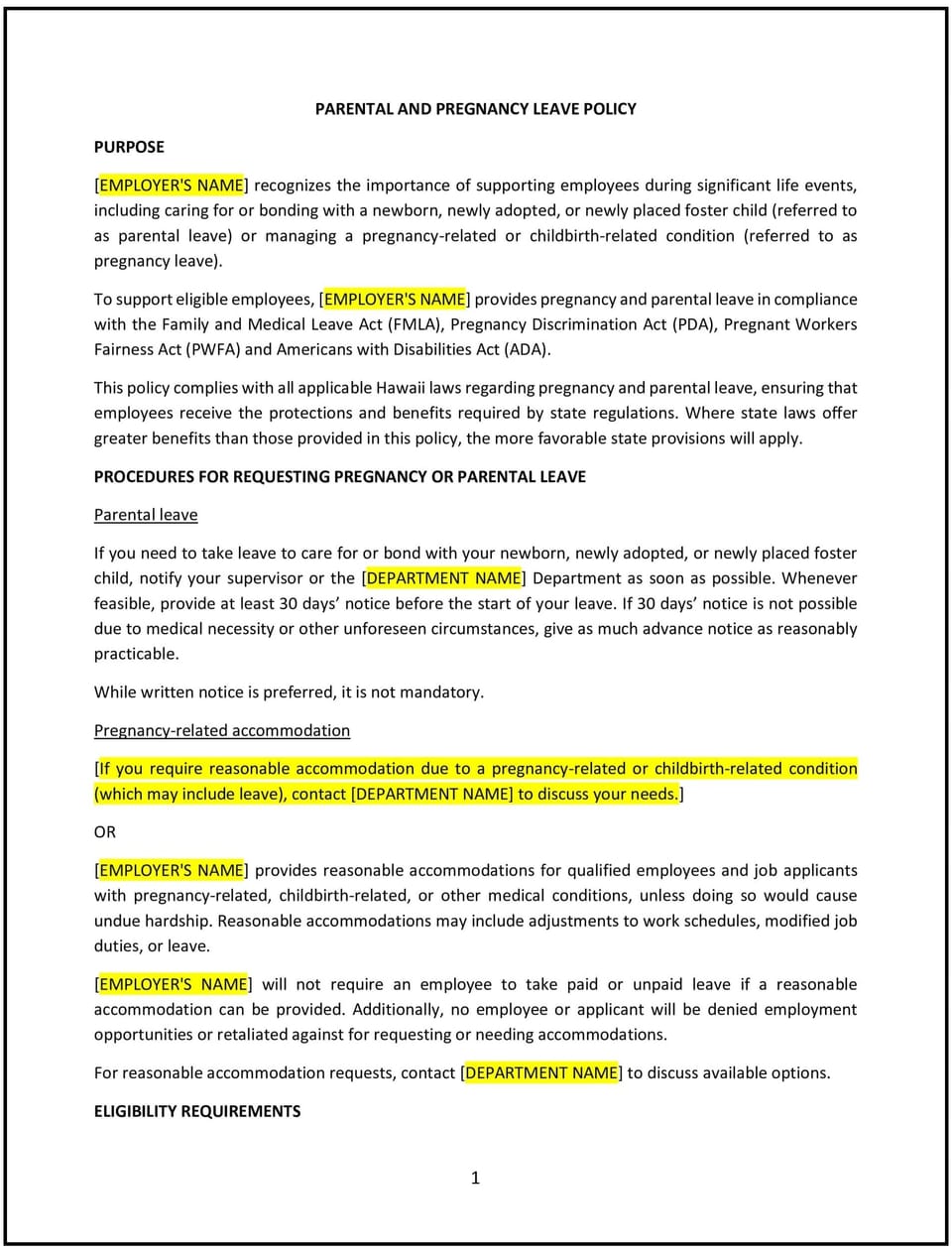Parental and pregnancy leave policy (Hawaii): Free template

Parental and pregnancy leave policy (Hawaiʻi)
A parental and pregnancy leave policy helps Hawaiʻi businesses establish guidelines for employees who need time off for pregnancy, childbirth, adoption, or fostering a child. This policy outlines procedures for requesting leave, managing work responsibilities, and ensuring job protection, while addressing Hawaiʻi’s unique cultural and legal considerations. It is designed to support employees during significant life events and promote a family-friendly workplace.
By implementing this policy, businesses in Hawaiʻi can improve employee morale, retain talent, and demonstrate a commitment to supporting work-life balance.
How to use this parental and pregnancy leave policy (Hawaiʻi)
- Define leave types: Specify the types of leave covered, such as pregnancy leave, maternity leave, paternity leave, adoption leave, or foster care leave.
- Establish eligibility: Outline which employees are eligible for leave, such as full-time or part-time staff, and any tenure requirements.
- Set leave duration: Define the maximum amount of leave employees can take, typically in alignment with Hawaiʻi state laws and federal regulations like the Family and Medical Leave Act (FMLA).
- Address paid vs. unpaid leave: Clarify whether leave is paid, unpaid, or a combination of both, and explain how employees can use accrued paid time off (PTO) during their leave.
- Create request procedures: Provide clear instructions for employees to request leave, including required documentation and advance notice when possible.
- Communicate the policy: Share the policy with employees during onboarding and through internal communications to ensure awareness and understanding.
- Train managers: Educate supervisors on how to handle leave requests, manage team workloads, and support employees during their leave.
- Monitor compliance: Regularly review leave requests and records to ensure adherence to the policy and address any issues promptly.
- Review and update the policy: Regularly assess the policy’s effectiveness and make adjustments as needed to reflect changes in laws, employee needs, or workplace dynamics.
Benefits of using this parental and pregnancy leave policy (Hawaiʻi)
This policy offers several advantages for Hawaiʻi businesses:
- Supports employee well-being: Providing leave for pregnancy, childbirth, or adoption helps employees balance work and family responsibilities.
- Improves retention: A supportive leave policy can increase employee satisfaction and loyalty, reducing turnover.
- Enhances workplace culture: A family-friendly approach fosters a positive and inclusive work environment.
- Attracts top talent: A strong parental and pregnancy leave policy makes the business more appealing to job seekers who value work-life balance.
- Aligns with legal requirements: The policy helps businesses comply with Hawaiʻi state laws and federal regulations, such as the FMLA and the Pregnancy Discrimination Act.
- Encourages accountability: Employees understand their responsibilities for requesting leave and managing their work before taking time off.
- Builds trust: Employees are more likely to trust leadership when they see a commitment to supporting their family needs.
Tips for using this parental and pregnancy leave policy (Hawaiʻi)
- Communicate the policy effectively: Share the policy with employees during onboarding and through regular reminders, such as emails or posters in common areas.
- Provide training: Educate managers on how to handle leave requests, manage team workloads, and support employees during their leave.
- Be flexible: Consider individual circumstances when approving leave requests and be open to accommodations when possible.
- Monitor compliance: Regularly review leave requests and records to ensure adherence to the policy and address any issues promptly.
- Be transparent: Clearly explain the policy’s purpose, benefits, and expectations to employees to build trust and cooperation.
- Review the policy periodically: Update the policy as needed to reflect changes in laws, employee needs, or workplace dynamics.
Q: Why should Hawaiʻi businesses adopt a parental and pregnancy leave policy?
A: Businesses should adopt this policy to support employees during significant life events, improve retention, and promote a family-friendly workplace.
Q: What types of leave are covered under this policy?
A: The policy should cover pregnancy leave, maternity leave, paternity leave, adoption leave, and foster care leave.
Q: Who is eligible for parental and pregnancy leave?
A: Eligibility should be clearly defined in the policy, typically including full-time or part-time employees who meet tenure requirements.
Q: How much leave can employees take?
A: Leave duration should align with Hawaiʻi state laws and federal regulations, such as the FMLA, typically up to 12 weeks per year.
Q: Is parental and pregnancy leave paid or unpaid?
A: Leave may be paid, unpaid, or a combination of both, depending on the business’s policies and applicable laws. Employees may also use accrued paid time off (PTO) during their leave.
Q: How should employees request leave?
A: Employees should follow the procedures outlined in the policy, including providing required documentation and giving advance notice when possible.
Q: How often should the policy be reviewed?
A: The policy should be reviewed annually or as needed to reflect changes in laws, employee needs, or workplace dynamics.
This article contains general legal information and does not contain legal advice. Cobrief is not a law firm or a substitute for an attorney or law firm. The law is complex and changes often. For legal advice, please ask a lawyer.


